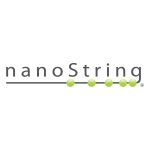Molecular Imaging Platform Leverages Hyb & Seq Chemistry to Spatially Profile Expression of 1,000+ Genes at Single Cell and Sub-Cell Resolution Across Tissue Samples
Available in Technology Access Program in H1-2021 with Commercial Instrument Launch Expected in H2-2022
Details to be Shared During Investor and Analyst Day on Tuesday, December 1st
SEATTLE–(BUSINESS WIRE)–NanoString Technologies, Inc. (NASDAQ:NSTG), a leading provider of life science tools for discovery and translational research, today announced the development of a spatial molecular imaging platform, a next generation solution for multiplexed analysis of RNA and protein expression for individual cells within a tissue sample.
The spatial molecular imager combines the power of high-plex profiling with high-resolution imaging to enable the analysis of hundreds to thousands of RNAs or proteins directly from single cells within morphologically intact tissue samples. The platform utilizes the company’s advanced Hyb & Seq chemistry, which over the last 18 months has been optimized for in situ spatial analysis. The platform is capable of profiling RNA and protein within a single cell down to sub-cellular resolution in multiple tissue types. To date, prototype systems have imaged RNA from as many as 1,000+ genes simultaneously across thousands of individual cells in Formalin-Fixed Paraffin Embedded (FFPE) tissue.
Tissue biology takes place on several spatial scales including multi-cellular, single cell and the sub-cellular levels. The GeoMx® Digital Spatial Profiler (DSP) enables multi-cellular analysis at the whole transcriptome level to elucidate the behavior of populations of cells, such as those within a tumor or the tumor microenvironment. NanoString is developing the spatial molecular imager to address the unmet need for high-plex spatial analysis of single cells and sub-cellular resolution, ideally suited for targeted applications, such as creating cell atlases or studying cell-cell interactions. The GeoMx DSP and the spatial molecular imager are highly synergistic, creating a spatial biology portfolio that spans the continuum from targeted to whole transcriptome analysis, and from multicellular resolutions down to single cell and sub cellular applications.
“Spatial imagers measuring RNA and protein in situ at single-cell and sub-cell resolution are expected to emerge as an important product category over the next several years,” said Brad Gray, president and CEO. “Our spatial molecular imaging platform can profile RNA and protein in FFPE with category-leading plex as well as high sensitivity and high resolution. Together, our GeoMx DSP and spatial imager form the leading spatial biology portfolio, spanning from discovery and translational research to clinical diagnostics.”
“Researchers and clinicians have gained tremendous insights from the revolution in single cell biology in recent years, but the cellular context was always lost,” said Christopher Mason, Ph.D., a geneticist who recently published research using GeoMx. “Now, biological discoveries can be elucidated from high-plex, multi-omic spatial imaging, revealing the key spatial interactions within and between normal or diseased tissues (e.g. COVID-19, cancer) and how these cells communicate and mediate phenotypes, change over time, and respond to therapies.”
“Spatial molecular imaging opens up new possibilities to understand the diversity of T-cells infiltrating a tumor at the single cell level without dissociating tissue. Our work under the Technology Access Program has produced results on the location of different T-cell subsets and their interaction with tumors and could reveal which T-cell subsets are most important for controlling tumors,” said Evan Newell, Ph.D., Associate Professor, Vaccine and Infectious Disease Division, the Fred Hutchinson Cancer Research Center.
The company plans to provide researchers access to the prototype versions of spatial molecular imaging platform through a Technology Access Program (TAP) beginning in 2021. Under the program, a TAP customer can submit tissue samples to NanoString to be analyzed using the spatial molecular imager and resulting data analysis reported back to the customer by NanoString. Full commercial launch of the spatial imaging solution consisting of instruments, consumables, and software is expected in the second half of 2022.
The Hyb & Seq chemistry was originally developed as part of a hybridization-based sequencing program. The company formed a strategic collaboration with Lam Research, under which Lam Research provided $50 million in funding and access to their industry-leading semi-conductor technology. This collaboration resulted in a robust and scalable chemistry that can be applied to a wide range of applications.
The company is hosting an Investor and Analyst Day webcast at 11:30am ET on Tuesday, December 1st, and will highlight the development program and new capabilities of the platform. Interested parties can access the webcast through the company’s website at https://investors.nanostring.com/events-webcasts. The webcast will be available on the company site for 90 days.
Researchers interested in participating in NanoString’s Technology Access Program should contact us at TAP@nanostring.com.
To learn more about NanoString’s GeoMx Digital Spatial Profiler, please visit https://www.nanostring.com/products/geomx-digital-spatial-profiler/geomx-dsp.
About NanoString Technologies, Inc.
NanoString Technologies is a leading provider of life science tools for discovery and translational research. The company’s nCounter® Analysis System is used in life sciences research and has been cited in approximately 3,800 peer-reviewed publications. The nCounter Analysis System offers a cost-effective way to easily profile the expression of hundreds of genes, proteins, miRNAs, or copy number variations, simultaneously with high sensitivity and precision, facilitating a wide variety of basic research and translational medicine applications, including biomarker discovery and validation. The company’s GeoMx® Digital Spatial Profiler enables highly-multiplexed spatial profiling of RNA and protein targets in a variety of sample types, including FFPE tissue sections.
For more information, please visit www.nanostring.com.
NanoString, NanoString Technologies, the NanoString logo, GeoMx, and nCounter are trademarks or registered trademarks of NanoString Technologies, Inc. in various jurisdictions.
Contacts
Doug Farrell, NanoString
Vice President, Investor Relations & Corporate Communications
dfarrell@nanostring.com
Phone: 206-602-1768

